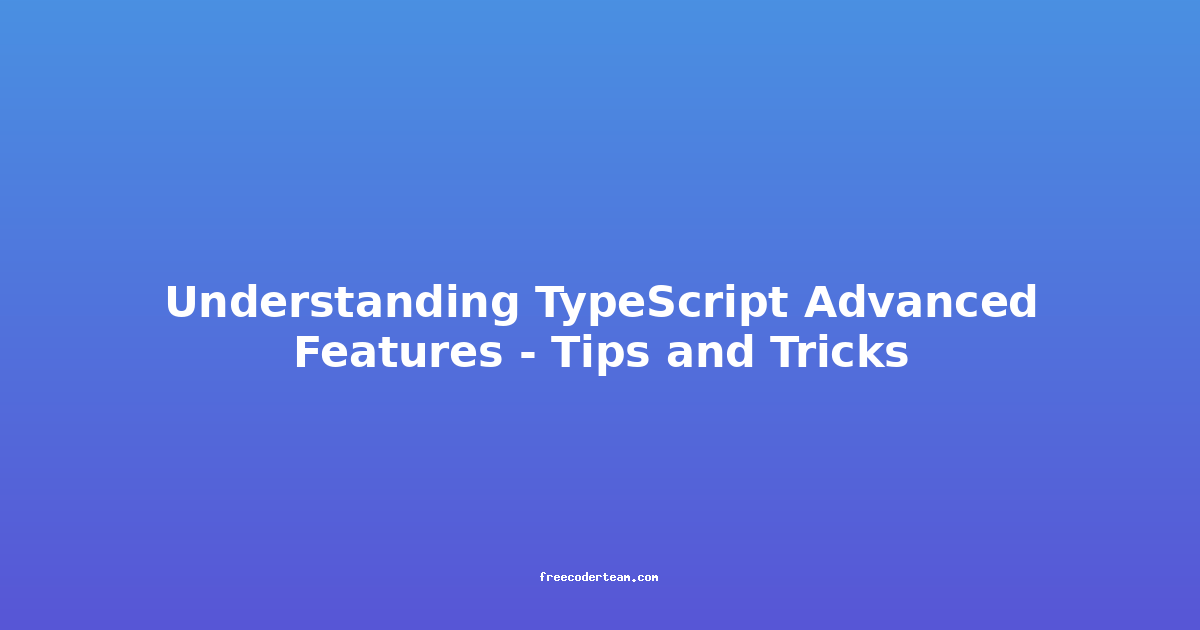Understanding TypeScript Advanced Features: Tips and Tricks
TypeScript is a powerful superset of JavaScript that adds static typing, enhanced tooling, and advanced features to help developers build robust and maintainable applications. While the basics of TypeScript are straightforward, its advanced features can significantly elevate your development workflow. In this blog post, we'll dive into some of TypeScript's most powerful and lesser-known features, providing practical examples, best practices, and actionable insights.
Table of Contents
- Introduction to Advanced Features
- 1. Utility Types
- 2. Discriminated Unions
- 3. Mapped Types
- 4. Generics
- 5. Parameter Properties
- 6. Conditional Types
- 7. Class Extensibility
- 8. Best Practices and Tips
- Conclusion
Introduction to Advanced Features
TypeScript's advanced features are designed to make your code more expressive, reusable, and maintainable. While TypeScript's core functionality is sufficient for many projects, mastering these advanced features can help you tackle complex scenarios and write more efficient code.
1. Utility Types
Utility types are predefined generic types that allow you to transform and manipulate existing types. They are incredibly useful for simplifying type declarations and making your code more concise.
Example: Omit and Pick
The Omit and Pick utility types are used to create new types by removing or selecting specific properties from an existing type.
interface User {
id: number;
name: string;
email: string;
age: number;
}
// Using Omit to remove specific properties
type UserWithoutEmail = Omit<User, "email">;
// Using Pick to select specific properties
type UserSummary = Pick<User, "id" | "name">;
const user: User = {
id: 1,
name: "John Doe",
email: "john@example.com",
age: 30,
};
const summary: UserSummary = {
id: user.id,
name: user.name,
};
Best Practice: Use Utility Types for Type Manipulation
Instead of manually creating new types, utility types can save time and reduce errors. They are especially useful when working with large interfaces or when you need to modify types dynamically.
2. Discriminated Unions
Discriminated unions allow you to create complex types that can represent multiple possible shapes, each with a unique property (the "discriminator") that distinguishes it from others. This pattern is particularly useful in scenarios like API responses or event handling.
Example: Discriminated Union for API Responses
interface SuccessResponse {
type: "success";
data: any;
}
interface ErrorResponse {
type: "error";
message: string;
}
type ApiResponse = SuccessResponse | ErrorResponse;
function handleResponse(response: ApiResponse): void {
if (response.type === "success") {
console.log("Success:", response.data);
} else if (response.type === "error") {
console.error("Error:", response.message);
}
}
const successResponse: ApiResponse = {
type: "success",
data: { userId: 1, name: "John Doe" },
};
const errorResponse: ApiResponse = {
type: "error",
message: "User not found",
};
handleResponse(successResponse);
handleResponse(errorResponse);
Best Practice: Use Discriminated Unions for Polymorphic Data
Discriminated unions are ideal for scenarios where you need to handle multiple types of data with a common structure. The discriminator ensures type safety and makes it easy to perform type narrowing.
3. Mapped Types
Mapped types allow you to transform existing types by applying a transformation to each property. This is particularly useful for creating types like read-only versions of interfaces or modifying the types of properties.
Example: Creating a Read-Only Type
interface User {
id: number;
name: string;
email: string;
}
// Creating a read-only version of the User interface
type ReadOnlyUser = {
readonly [K in keyof User]: User[K];
};
const user: User = {
id: 1,
name: "John Doe",
email: "john@example.com",
};
const readOnlyUser: ReadOnlyUser = user;
// This will throw a compile-time error because readOnlyUser is read-only
// readOnlyUser.name = "Jane Doe"; // Error: cannot assign to read-only property
Best Practice: Use Mapped Types for Customizing Types
Mapped types are versatile and can be used to create complex transformations. They are particularly useful when you need to apply a uniform change across all properties of a type.
4. Generics
Generics allow you to create reusable types and functions that can work with any type. They are essential for building reusable libraries and utility functions.
Example: Generic Function for Filtering
function filterArray<T>(array: T[], predicate: (item: T) => boolean): T[] {
return array.filter(predicate);
}
const numbers = [1, 2, 3, 4, 5];
const evenNumbers = filterArray(numbers, (num) => num % 2 === 0);
const users = [
{ id: 1, name: "John" },
{ id: 2, name: "Jane" },
];
const userNamedJohn = filterArray(users, (user) => user.name === "John");
console.log(evenNumbers); // [2, 4]
console.log(userNamedJohn); // [{ id: 1, name: "John" }]
Best Practice: Use Generics for Reusability
Generics enable you to write functions and types that can work with any type, making your code more flexible and reusable. They are especially useful in utility libraries and higher-order functions.
5. Parameter Properties
Parameter properties allow you to define class properties directly from constructor parameters, reducing boilerplate code. This feature is particularly useful when you have many constructor parameters.
Example: Using Parameter Properties
class User {
constructor(private readonly id: number, public name: string) {}
getId(): number {
return this.id;
}
getName(): string {
return this.name;
}
}
const user = new User(1, "John Doe");
console.log(user.getName()); // John Doe
Best Practice: Use Parameter Properties for Concise Class Definitions
Parameter properties are a great way to reduce redundancy in class definitions. They make the code more readable and maintainable, especially in classes with many properties.
6. Conditional Types
Conditional types allow you to create types that depend on a condition. They are particularly useful for creating complex type systems or handling type guards.
Example: Conditional Type for Nullable Properties
type Nullable<T> = T | null;
type NonNullable<T> = T extends null | undefined ? never : T;
interface User {
id: number;
name: string | null;
email: string | null;
}
// Using NonNullable to remove nullability
type NonNullableUser = {
[K in keyof User]: NonNullable<User[K]>;
};
const user: NonNullableUser = {
id: 1,
name: "John Doe",
email: "john@example.com",
};
// This will throw a compile-time error because 'name' is no longer nullable
// user.name = null; // Error: Type 'null' is not assignable to type 'string'
Best Practice: Use Conditional Types for Type Manipulation
Conditional types are powerful tools for creating types that adapt based on conditions. They are especially useful when working with complex type systems or when you need to handle nullability or optional properties.
7. Class Extensibility
TypeScript provides several ways to extend and compose classes, including inheritance, mixins, and decorators. These features allow you to create flexible and reusable class hierarchies.
Example: Using Mixins
Mixins are a popular pattern for combining functionality in TypeScript. They allow you to create reusable class behaviors without using inheritance.
function Loggable<TBase extends { new (...args: any[]): {} }>(
BaseClass: TBase
) {
return class extends BaseClass {
log(message: string): void {
console.log(`[${this.constructor.name}]: ${message}`);
}
};
}
class User {
constructor(public name: string) {}
}
const LoggableUser = Loggable(User);
const user = new LoggableUser("John Doe");
user.log("Hello, TypeScript!"); // [LoggableUser]: Hello, TypeScript!
Best Practice: Use Mixins for Reusable Behavior
Mixins provide a flexible way to compose classes without the limitations of multiple inheritance. They are particularly useful when you need to add cross-cutting concerns (like logging or validation) to multiple classes.
8. Best Practices and Tips
1. Use Type Aliases for Readability
Type aliases can make your code more readable by giving meaningful names to complex types.
type UserId = number;
type UserName = string;
interface User {
id: UserId;
name: UserName;
}
2. Leverage Inference for Simpler Generics
TypeScript can often infer generic types from function arguments, reducing the need to explicitly specify them.
function identity<T>(value: T): T {
return value;
}
// No need to specify the type explicitly
const result = identity("Hello"); // Inferred as string
3. Use unknown for Untyped Data
The unknown type is a safer alternative to any when you want to handle untyped data. It forces you to narrow the type before using it.
function processInput(input: unknown): void {
if (typeof input === "string") {
console.log(input.toUpperCase());
} else {
console.log("Not a string");
}
}
4. Use as const for Literal Types
The as const assertion allows you to preserve the literal types of values, which can be useful when working with configuration objects.
const config = {
port: 3000,
host: "localhost",
} as const;
// The type of config is inferred as:
// {
// readonly port: 3000;
// readonly host: "localhost";
// }
5. Be Mindful of Type Inference
TypeScript's type inference can sometimes lead to unexpected results, especially with union types. Be explicit when the inferred type doesn't match your expectations.
Conclusion
Mastering TypeScript's advanced features can significantly enhance your development experience. Whether you're working with utility types, discrimininated unions, or generics, these tools can help you write more expressive, maintainable, and type-safe code. By following best practices and leveraging the power of TypeScript's advanced features, you can build robust applications that scale over time.
Remember, the key to leveraging TypeScript's advanced features is to use them thoughtfully and appropriately. Overusing these features can lead to overly complex code, so always prioritize readability and maintainability. With practice and experience, you'll find the right balance to make the most of TypeScript's capabilities. Happy coding! 💻✨
If you have any questions or need further clarification, feel free to ask!




